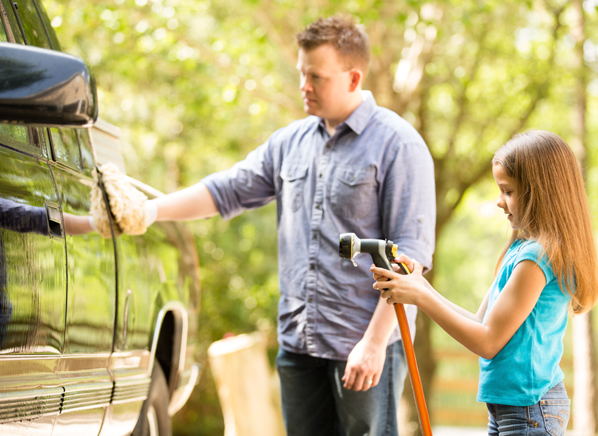For many vehicle owners, washing a car by hand is a therapeutic act as beneficial for the person’s state of mind as to the vehicle’s appearance. That’s good, because frequent washing is also the best way to maintain a new-car finish. But as simple as washing your car may seem, there are some things to watch for so that you don’t accidentally scratch or degrade the finish. Here are some basic car-washing tips:
When should I wash the car?
Don’t... wait for a layer of crud to accumulate before washing. Dead bugs, bird droppings, and chemicals from the atmosphere all leach acids that can strip away wax and eventually eat into your car’s paint. If left too long, they can cause damage that requires sanding and repainting the area to correct.
Do… wash off dead bugs, bird droppings, and tree-sap mist as soon as possible. Other than this, a weekly car wash will keep the finish in its best shape. In addition, if you live in an area that suffers from acid rain, rinse your vehicle off after a period of rainy weather. Otherwise, acidic chemicals in the rainwater will be left on the surface after the droplets have evaporated, leaving a mark that can permanently mar the paint.
What kind of products should I use?
Don’t… use household cleaning agents like hand soap, dishwashing detergent, or glass cleaner on the paint. These aren’t formulated for use on a car’s paint and may strip off the protective wax.
Do… use a dedicated car-wash product, which is milder and specifically designed for use on automotive paint. Apply the suds with a large, soft natural sponge or a lamb’s-wool mitt. (See our car wax report for tips and advice on all types of waxes.)
Grease, rubber, and road-tar deposits picked up from the road often accumulate around the wheel wells and along the lower edge of the body. These can be stubborn to remove and may require a stronger product, such as a bug-and-tar remover. Use a soft, nonabrasive cloth to remove these deposits, as they can quickly blacken your sponge.
Do… use a separate sponge to clean the wheels and tires, which may be coated with sand, brake dust, and other debris that could mar the car’s finish. Mild soap and water may work here; if not, a dedicated wheel cleaner may be required. Be sure the cleaner is compatible with the type of finish (paint, clear-coat, chrome, etc.) used on the wheels. A strong formula intended for mag wheels, for instance, can damage the clear coat that’s used on the wheels that come on today’s cars. To be on the safe side, choose a cleaner that’s labeled as safe for use on all wheels.
Are there any general guidelines I should follow when washing a car?
Don’t… wash your car when the body is hot, such as immediately after driving it or after it has been parked in direct sunlight for awhile. Heat speeds the drying of soap and water, making washing more difficult and increasing the chances that spots or deposits will form.
Don’t… move the sponge in circles. This can create light, but noticeable scratches called swirl marks. Instead, move the sponge lengthwise across the hood and other body panels. And don’t continue using a sponge that’s dropped on the ground without thoroughly rinsing it out. The sponge can pick up dirt particles that can scratch the paint.
Do… rinse all surfaces thoroughly with water before you begin washing to remove loose dirt and debris that could cause scratching. Once you begin, concentrate on one section at a time, washing and rinsing each area completely before moving on to the next one. This ensures that you have plenty of time to rinse before the soap dries. Start at the top, and then work your way around the car. Use a hose without a nozzle and let the water flow over the car from top to bottom. This creates a sheeting action that helps minimize pooling of water.
Do… work the car-wash solution into a lather with plenty of suds that provide lots of lubrication on the paint surface. And rinse the sponge often. Using a separate bucket to rinse the sponge keeps dirt from getting mixed into the sudsy wash water.
How should I dry the car when I’m done?
Don’t… let the car air dry, and don’t expect a drive around the block to do an effective job. Either will leave watermarks caused by minerals in hard water. In addition, don’t use an abrasive towel or other material that can leave hairline scratches in the paint.
Do… use a chamois (natural or synthetic) or soft terry towels. If you choose towels, you may need several. It’s best to blot the water up instead of dragging the towel or chamois over the paint. The drying process can be sped up by using a soft squeegee to remove most of the water on the body, but be sure the rubber is pliable and that it doesn’t pick up bits of dirt that can cause scratches.

